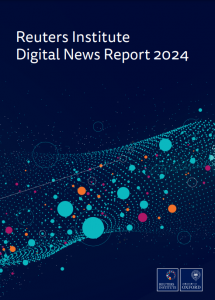The Outlook: AI in the News – Re-shaping the Public Arena
AI in the News private lecture insights by Dr. Felix Simon, Latest Resources and all Open Media Innovation Opportunities
IPI's Innovation Team
Jul 2, 2024
This text comes from IPI’s newsletter The Outlook. Click here to sign up to receive future editions directly to your inbox.
In this week’s newsletter, we share insights from a fascinating lecture titled AI in the News – Re-shaping the Public Arena by Dr. Felix M. Simon (Reuters Institute).
This private lecture was organized for the Central Europe Independent Media Network. Dr. Simon kindly allowed IPI’s innovation team to share a recap of his research on AI’s impact on the news, audience reactions, and ethical considerations. We summarized his findings in 4 steps on if and how AI can be used in your media. Scroll down to find other open IPI Media Innovation opportunities and resources.
Harnessing AI insights for newsrooms
…no ‘reality machines’
AI has transformed journalism, audience engagement, and operations. Despite dominating the technological discourse, many open questions and risks linger about using generative AI tools in journalism. But, what do we know from research about the role of AI in the news industry today?
To start, Dr. Simon underlines that AI language models can’t convey “truth”, but rather an approximation of reality. So why does the news industry even bother with Al?
- Curiosity, FOMO, “Shiny New Things Syndrome”
- Money & Performance
- Improving editing, copy, distribution and new products
- Macro-dynamics and tech industry trends
Steps to understand AI in your newsroom
Step 1. Understand how AI can look at your journalism by thinking of “the way the news gets made”. This process can be approached as gatekeeping of information. AI can be used throughout the whole gatekeeping chain, from production to distribution.
➡ Efficiency & Effectiveness: Look into AI-powered transcription at Rappler or in-house editorial AI tools – MAGNA by JP/Politikens Hus, serving to assist, not replace journalists.
➡ New Styles & Formats: See how AI can empower your visual storytelling, like in this piece by Semafor.
➡ Personalisation & Recommendation: create custom newsletters and feeds for individuals.
Step 2. Understand how audiences think about GenAI, including the news context and its impact on trust. Be aware of your audience’s demographic, psychographic, and behavioural information. Reuters research shows:
➡ A substantial number of people (20-30%) are unaware of popular AI tools and hold generally more pessimistic views of AI.
➡ Discomfort with consuming AI content is (still) widespread.
Step 3. Learn how AI affects SEO and how it can help you navigate search engine’s parameters and rules.
➡ Check Google’s recent rollout of automated AI-generated overviews and the issue of factual accuracy.
➡ Use AI to stay on top of the main events, but stay vigilant about the accuracy of the results.
Step 4. Beware of the risks and ethics of AI. From perpetuating bias and poor data quality used in AI training to the “explainability” issue and harmful reproductions of existing inequalities, there are many factors to consider when using AI.
According to Felix Simon, here are some good daily practices:
➡ Always verify the information delivered by AI
➡ Consider copyright and privacy, especially with sensitive data input and output
➡ Use sand-boxed versions and disable AI training (if possible)
➡ Be transparent about your use of AI
➡ Look out for the Implications of Tech and platform dependency, as well as the political economy of AI on your media’s autonomy.
💡Finally, remember, that AI is not a must and using AI should not put at risk your journalistic values and integrity. Tread lightly.
Next Step Forward
|
|
Continue exploring AI’s implications on news with the Reuters Institute Digital News Report 2024. The study reveals new findings about the consumption of online news internationally, based on a YouGov survey of more than 95,000 people in 47 countries representing half of the world’s population.
Here are just a few learnings on global digital news trends:
- There is a decline in the use of Facebook for news and a growing reliance on a range of alternatives including private messaging apps and video networks.
- As a part of the shift, video is becoming a more important source of online news, especially among younger groups, and especially in short formats.
- As publishers embrace the use of AI we find widespread suspicion about how it might be used, especially for ‘hard’ news stories such as politics or war. There is more comfort with the use of AI in behind-the-scenes tasks such as transcription and translation; in supporting rather than replacing journalists.
Innovation Deck: Open IPI Media Innovation Programmes
🔎 How does your newsroom interact with AI?
What are some of the challenges it could help you tackle?
Share with us and help us shape the next issues of The Outlook!


